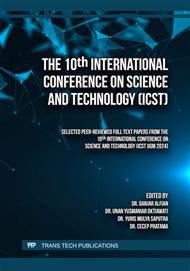[1]
Barrat, A., Barthelemy, M. and Vespignani, A. Dynamical Processes on Complex Networks (Cambridge University Press, New York, 2008).
Google Scholar
[2]
Flake, G. W. The Computational Beauty of Nature Computer Explorations of Fractals, Chaos, Complex Systems, and Adaptation (MIT Press, London, 2000), p.141.
Google Scholar
[3]
Baker, G. L. and Gollub, J. P., Chaotic Dynamics: An Introduction (Cambridge University Press, New York, 1990), p.76.
Google Scholar
[4]
Baptista, M. S. and Caldas, I. L. 'Dynamics of the Kicked Logistic Map', Chaos, Solitons and Fractals, 7(3), 325–336 (1996).
DOI: 10.1016/0960-0779(95)00083-6
Google Scholar
[5]
Collet, P., and Eckmann, J.-P., Iterated Mapson the Interval as Dynamical Systems (Birkha ü ser, Boston, 2009), Pp. 1-7.
Google Scholar
[6]
Gabriel, J. P., Saucy, F. and Bersier, L. F. 'Paradoxes in the logistic equation?', Ecological Modelling, 185(1), 147–151 (2005).
DOI: 10.1016/j.ecolmodel.2004.10.009
Google Scholar
[7]
Cielen, D., Meysman, A. D. B. and Ali, M. Introducing Data Science. (Manning Publications Co., New York, 2016), p.12.
Google Scholar
[8]
Mueller, J.P. and Massaron, L. Machine Learning for Dummies, (John Wiley & Sons, Inc., New Jersey, 2016) pp.219-236
Google Scholar
[9]
Roy, S., Road, B.B., Pradesh, M., & Rana, D. (n.d.). Machine Learning in Nonlinear Dynamical Systems. General Article, Springer. (2021)
Google Scholar
[10]
Boullé, N., Dallas, V., Nakatsukasa, Y., & Samaddar, D. Classification of chaotic time series with deep learning. Physica D: Nonlinear Phenomena, 403, 132261 (2020).
DOI: 10.1016/j.physd.2019.132261
Google Scholar
[11]
Monga, B., & Moehlis, J., Supervised learning algorithms for controlling underactuated dynamical systems.
Google Scholar
[12]
Physica D: Nonlinear Phenomena, 412, 132621 (2020).
Google Scholar
[13]
Ahmed, S. E., San, O., Rasheed, A., & Iliescu, T., A long short-term memory embedding for hybrid uplifted reduced order models. Physica D: Nonlinear Phenomena, 409, 132471 (2020).
DOI: 10.1016/j.physd.2020.132471
Google Scholar
[14]
May, R.M. 'Simple mathematical models with very complicated dynamics', Nature, 261(5560), 459–467, (1976).
DOI: 10.1038/261459a0
Google Scholar
[15]
Moon, F.C. Chaotic and Fractal Dynamics, SIAM Review. Weinheim: Wiley-VCH, (2004).
Google Scholar
[16]
Moysis, L. et al. 'A chaotic path planning generator based on logistic map and modulo tactics', Robotics and Autonomous Systems, 124, 103377, (2020).
DOI: 10.1016/j.robot.2019.103377
Google Scholar
[17]
Müller, A.C. and Guido, S. Introduction to Machine Learning with Python, Proceedings of the Specia lity Conference on Infrastructure Condition Assessment: Art, Science, Practice. United States: O'Reilly Media, Inc., (2017)
Google Scholar
[18]
Brownlee, J. 'Long Short-Term Memory Networks with Python', Machine Learning Mastery with Python, 1(1), 228, (2017).
Google Scholar
[19]
Rosenstein, M.T., Collins, J.J. and De Luca, C.J. 'A practical method for calculating largest Lyapunov exponents from small data sets', Physica D, 65 (1–2), 117–134. (1993)
DOI: 10.1016/0167-2789(93)90009-p
Google Scholar


